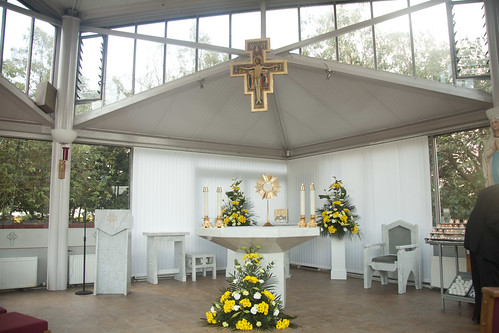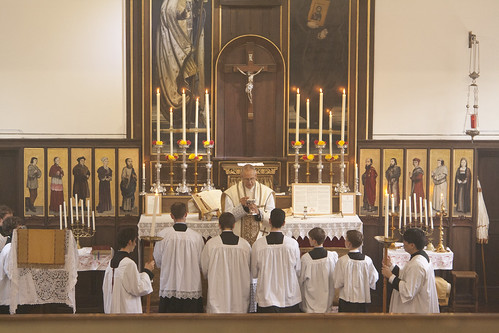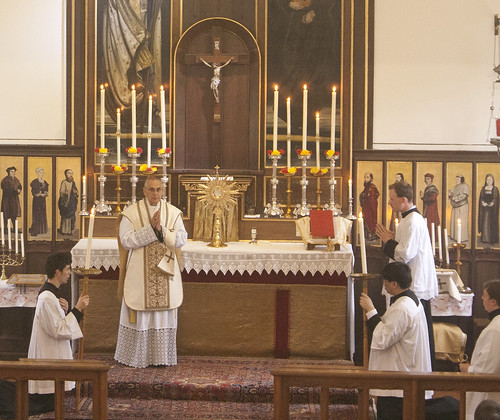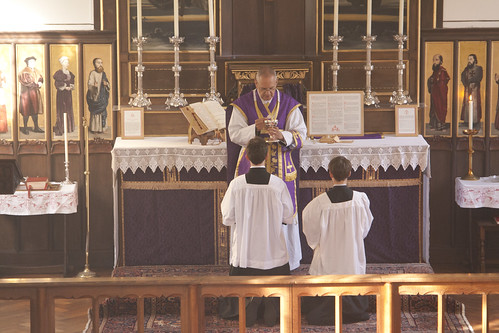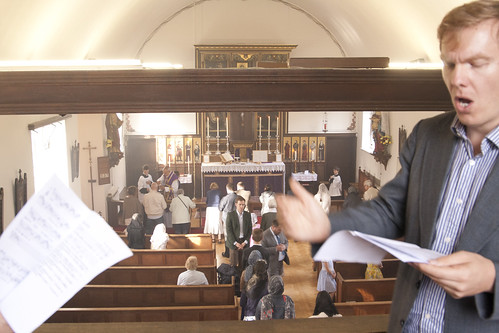Chairman's Blog
Some worries about Exposition of the Blessed Sacrament: Part 3
Fr Alexander Sherbrooke, in announcing perpetual exposition in St Patrick's Soho Square, reminds us of the tradition of Exposition in the Basilica of the Sacred Heart on Montmartre in Parish, established, with the church itself, as a national act of reparation. The Forty Hours devotion began as an act of reparation. What does this mean?
Benediction itself is not, primarily, an evangelising tool. It is an opportunity for us to give special honour to Christ in the Blessed Sacrament. We do this by the ceremonies, prayers, and chants, and the watching, in the 40 Hours, through the night. It creates an opportunity to do something a bit like a pilgrimage or a great act of charity, but directed towards the Blessed Sacrament specifically, in recognition of the insults against the holiness of God. It is not something we use for some other purpose. What we, like the builders of Sacré-Cœur, may hope, is that God, being appeased, will visit us and leave a blessing behind.
Let me make explicit the extension of this point to the liturgy in general. We should not use Mass to attract converts. We should celebrate Mass with all possible solemnity because it is an act of worship to God, and that should be done with all possible solemnity. We should, further, do whatever possible to excite the piety of the worshipers, to the same end. Worshipers, taking part in the liturgy, will be transformed by it; lukewarm Catholics will be made fervent; non-Catholics, even, may recognise in it the God who is makes Himself known through the liturgy. But that last effect is not what it is for. Unlike works of Catholic apologetics, unlike preaching, it is not an instrument we use to gain this goal. To make it an instrument in our plans is to undermine its very nature, something which is offered not to men but to God.
That is compatible with saying, what I have said myself often, that the liturgy has a place in the New Evangelisation. There's nothing wrong, either, with the thought that greater use of Exposition will be good for souls. What would be wrong, on the liturgy, would be to deflect it from its primary function as the worship of God. What would be wrong, with Exposition, would be to deflect it from its primary function, which is the creation of an opportunity for a special worship of God in the Blessed Sacrament as a pious work.
How could that last thing happen? Look at this photograph.
This chapel is part of the shrine complex at Carfin, outside Glasgow, which I visited a few years ago. It is a long-established Catholic shrine and is impressive in many ways. One of the more recent features of the place is a chapel of Perpetual Exposition. Making a detour on a long journey through Scotland, I visited it on a weekday in September. Not surprisingly the place was very quiet. In this chapel there was an old priest - you can just see him on the right. But apart from me and my family, during our brief visit, it was otherwise empty. At a wild guess I'd say that apart from its custodian, if that's what he was (and good for them to have one) that chapel would have been visited by a handful of people in the course of a weekday at most, and more probably by one or two.
In parts of the Philippines, I understand, there are Blessed Sacrament Chapels with the Sacrament exposed which are completely empty all day long. Apart, of course, from the air conditioning unit, and Our Lord.
There is no worship going on here when no-one is present. Empty Exposition Chapels are attempts to make good things happen simply by putting the Blessed Sacrament out. I'm sure no-one plans them to be empty, but bishops must realise that they are after a while, and to the extent that the attitude is 'Oh well let's keep on the Exposition for the odd chance person', we have a problem. We are moving intot the realm of treating the Blessed Sacrament like a magic amulet, which does its work without reference to the response of human beings.
I'm sure Fr Sherbrooke has plans to ensure that the Blessed Sacrament in his church is not left alone. I don't want to give the impression that these posts are a criticism of his specific scheme. This particular worry is more likely to be realised in smaller and less well-supported parishes. More to the point, I am concerned about the general attitude we are taking to the Exposition of the Blessed Sacrament. Why are we doing it? What is it all about?
Promoters of Exposition may say: it creates the opportunity for prayer before the Blessed Sacrament Exposed which is a good thing even if only a small number of people use it. But hang on: people can pray before the Blessed Sacrament in the Tabernacle. Are we besieged by people praying before the Blessed Sacrament, that we can feel the pent-up demand for Exposition? Are people who do not pray before the Tabernacle ready to pray before the Monstrance?
Here's another way of looking at it. It is always edifying to see the people praying, for example, in the exquisitely beautiful Blessed Sacrament Chapel in Westminster Cathedral, a place which attracts many devout visitors. If I wanted to show a non-believer something about the nature of Catholic belief and the intensely holy thing which we have in this great Sacrament, I might show them these good people on their knees in that lovely chapel, and the very palpable prayerful atmosphere there. The decoration, the architecture, the whole arrangement gives glory to what is contained in the Tabernacle, and there are the people, they are there any time you drop by, showing their love and devotion to Our Lord, on their knees.
Would I show my non-believing friend the empty Exposition chapel at Carfin? If I did, what would he see? Not having the 'eyes of Faith', he would see a wafer of bread exposed to view but apparently ignored, neglected, and held in little regard, by those who claim that this is the Incarnate God.
I haven't said anything about the danger of profanation, but that is very real also.
I just want to say: before we start to promote Exposition everywhere and all the time, let's not lose sight of what it is all about. We expose the Blessed Sacrament to view not to show off, not to thrust into the spotlight the holiest thing we have in the hope that it have some magical effect on our opponents. We do it in order to honour Him. We honour Him by the prayers and ceremonies of Benediction and the Forty Hours, and by the special efforts of maintaining a schedule of watching with Him. If that's not happening, then we are not going to be reaping any evangelical fruits from it. Our fate will be that of the corrupt sons of Eli, killed by the Philistines for their presumption.
Support the work of the LMS by becoming an 'Anniversary Supporter'.
Some worries about Exposition of the Blessed Sacrament: Part 2
The problem is making something which should be done with as much solemnity as possible workaday and prosaic. I do appreciate the intentions of those who try to encourage devotion to the Blessed Sacrament but starting with Exposition rather than the reception of Holy Communion and reverence to the reserved Blessed Sacrament seems to me a dangerous mistake.
Not by taking what is holy, the holiest thing we have, and casting it before the swine. That's not the way to convert the swine.
There is a wonderful teaching on this in the Old Testament. During the time of the Judges and Kings in Israel the Hebrews had something which represented the presence of God in their midst: the Ark of the Covenant. The presence of God manifested itself in a visible way in the Temple when the Ark was installed there by Solomon. The Ark was so holy it had to be carried on poles, and only by a special, holy, class of people: a class of people set apart for liturgical functions. When one of these, a man called Uzzah, touched the Ark, perhaps because he was falling over, perhaps because the Ark was in danger of falling over, he was instantly killed by God. This kind of story is incomprehensible to many modern Christians, but it has a message for us, and it is clear enough.
After a period of not being very upright, the Hebrews found themselves in trouble: they were being defeated by their enemies. So, knowing the terrifying power of the Ark, they thought: let's use this. Let's have it in the army and march into battle with it, a bit like when Joshua was commanded to have the Ark carried around Jericho all those years earlier. And what happened? They were defeated and slaughtered, and the Ark was captured.
We cannot use the Blessed Sacrament. We cannot use the liturgy. Once we start using these things they become degraded and, in fact, useless. Fr Alexander Sherbrooke, in announcing perpetual exposion in St Patrick's Soho Square, refers to the tradition of Exposition in the Basilica of the Sacred Heart on Montmartre in Parish. What was that for, however? That church was built as a national act of reparation. The Forty Hours devotion began as an act of reparation. Benediction itself is not, primarily, an evangelising tool. It is an opportunity for us to give special honour to Christ in the Blessed Sacrament. We do this by the ceremonies, prayers, and chants, and the watching, in the 40 Hours, through the night. It creates an opportunity to do something a bit like a pilgrimage or a great act of charity, but directed towards the Blessed Sacrament specifically, in recognition of the insults against the holiness of God. It is not something we use for some other purpose. What we, like the builders of Sacré-Cœur, may hope, is that God, being appeased, with visit us and leave a blessing behind.
Let me make explicit the extension of this point to the liturgy in general. We should not use Mass to attract converts. We should celebrate Mass with all possible solemnity because it is an act of worship to God, and that should be done with all possible solemnity. We should, further, do what is possible to excite the piety of the worshipers, to the same end. Worshipers, taking part in the liturgy, will be transformed by it; lukewarm Catholics will be made fervent; non-Catholics, even, may recognise in it the God who is makes Himself known through the liturgy. But that is not what it is for. Unlike works of Catholic apologetics, unlike preaching, it is not an instrument we use to gain this goal. To make it an instrument in our plans is to undermine its very nature, something which is offered not to men but to God.
That is compatible with saying, what I have said myself, that the liturgy has a place in the New Evangelisation. There's nothing wrong, either, with the thought that Perpetual Exposition will be good for souls. What would be wrong, on the liturgy, would be to deflect it from its primary function as the worship of God. What would be wrong, with Exposition, would be to deflect it from its primary function, which is the creation of an opportunity for a special worship of God in the Blessed Sacrament.
How could that last thing happen? Look at this photograph.
This chapel is part of the shrine complex at Carfin, outside Glasgow, which I visited a few years ago. It is a long-established Catholic shrine and impressive in many ways. One of the more recent features of the place is a chapel of Perpetual Exposition. I was there on a weekday and the place was very quiet. In this chapel there was an old priest - you can see him on the right. But apart from me and my family, during our brief visit, it was otherwise empty. At a wild guess I'd say that apart from its custodian, if that's what he was (and good for them to have one) that chapel would have been visited by a handful of people in the course of the weekday at most, and more probably by one or two.
In parts of the Philipines, I understand, there are Blessed Sacrament Chapels with Perpetual Adoration which are completely empty all day long. Apart, of course, from Our Lord.
There is no worship going on here when no-one is present. Empty Exposition Chapels are attempts to make good things happen simply by putting the Blessed Sacrament out. I'm sure no-one plans them to be empty, but they must realise that they are after a while and to the extent that the attitude is 'Oh well let's keep on the Exposition for the odd chance person' I'd go so far to say that it is superstitious. It is treating the Blessed Sacrament like a magic amulet which does its work without reference to the response of human beings.
I'm sure Fr Sherbrooke has plans to ensure that the Blessed Sacrament in his church is not left alone. I don't want to give the impression that these posts are a criticism of his specific scheme. What they are are the expression of a worry about the use of Exposition which is more likely to be realised in smaller and less well-supported parishes. It is just to say: before we start to promote Exposition everywhere and all the time, let's not lose sight of what it is all about.
Support the work of the LMS by becoming an 'Anniversary Supporter'.
Some worries about Exposition of the Blessed Sacrament: Part 1
 This is not an isolated case from a far-away country. Below are photos from Youth 2000, one from a celebration in Cardiff, the other from Scotland. Notice the gesticulating young layman in the first, with the Blessed Sacrament, exposed, between him and the standing people. In the second it is possible to see the strange pyramid of candles supporting the monstrance, while a friar preaches, and the people (as far as I can tell), sit.
This is not an isolated case from a far-away country. Below are photos from Youth 2000, one from a celebration in Cardiff, the other from Scotland. Notice the gesticulating young layman in the first, with the Blessed Sacrament, exposed, between him and the standing people. In the second it is possible to see the strange pyramid of candles supporting the monstrance, while a friar preaches, and the people (as far as I can tell), sit.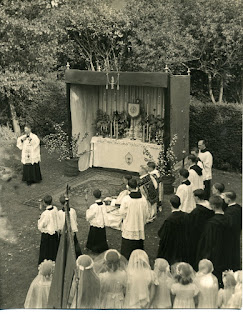 There is a lot going on here which needs to be unpacked. One thing is that this kind of event is a reaction against something clearly bad: the banishing of the Blessed Sacrament to an undistinguished corner of the church, if He is there at all; the loss of moments of contemplation in Mass; and the disappearance of Benediction and Blessed Sacrament Processions. These young Catholics want to be able to pray before Him.
There is a lot going on here which needs to be unpacked. One thing is that this kind of event is a reaction against something clearly bad: the banishing of the Blessed Sacrament to an undistinguished corner of the church, if He is there at all; the loss of moments of contemplation in Mass; and the disappearance of Benediction and Blessed Sacrament Processions. These young Catholics want to be able to pray before Him.Another Pro-Life Mass in Oxford
 Further to my proposal, following the abortion referendum in Ireland, for Masses of Reparation for abortion, we had one such Mass in Oxford recently; another is shortly to take place in London.
Further to my proposal, following the abortion referendum in Ireland, for Masses of Reparation for abortion, we had one such Mass in Oxford recently; another is shortly to take place in London.
Wednesday 4th July, 7:30pm
7pm Wednesday 4th July, Sung Mass.
Our Lady of the Assumption, 10 Warwick Street, London W1B 5LZ
These are both Votive Masses pro remissione peccatorum: for the remission (forgiveness) of sin.
I had proposed the celebration not only that Votive Mass but also of Masses in honour of Our Lady of Guadalupe. This title of the Blessed Virgin Mary refers to her appearance in 1531 in New Spain (now Mexico). Among other things she arranged a miraculous image of herself to be indelibly imprinted on the cactus-fibre cloak of the seer, a humble peasant; this image can still be seen. Its survival for nearly 500 years itself defies natural explanation; so does the means used to create the image. Our Lady of Guadalupe was declared Patroness of the Americas by Pope Pius XII in 1946. She has been adopted as a patron of the Pro-Life movement because the image represents her during pregnancy: a state indicated (in accordance with the conventions of the time) by her black girdle.
Her feast-day, where it is celebrated, is on 12th December (the date in 1531 when the miraculous image was created). My intention is that we have a Votive Mass of Our Lady of Guadalupe as close as possible to this date, and if possible before the end of the University term.
I can now announce that a Sung Votive Mass of Our Lady of Guadalupe will be celebrated in Oxford for the intentions of the Pro-Life movement:
6pm Wednesday 28th November
SS Gregory and Augustine, 322 Woodstock Road, OX2 7NS
Support the work of the LMS by becoming an 'Anniversary Supporter'.
Cardinal Müller on the liberal agenda
These astonishing but perceptive words of Gerhard, Cardinal Müller, former Prefect of the Congregation for the Doctrine of the Faith, from an interview with Catholic World Report, deserve as wide an audience as possible.
They consider the secularization and de-Christianization of Europe as an irreversible development. For this reason the New Evangelization—the program of John Paul II and Benedict XVI—is in their view a battle against the objective course of history, resembling Don Quixote’s battle against the windmills. They are seeking for the Church a niche where it can survive in peace. Therefore all the doctrines of the faith that are opposed to the “mainstream,” the societal consensus, must be reformed.
One consequence of this is the demand for Holy Communion even for people without the Catholic faith and also for those Catholics who are not in a state of sanctifying grace. Also on the agenda are: a blessing for homosexual couples, intercommunion with Protestants, relativizing the indissolubility of sacramental marriage, the introduction of viri probati and with it the abolition of priestly celibacy, approval for sexual relations before and outside of marriage. These are their goals, and to reach them they are willing to accept even the division of the bishops’ conference.
The faithful who take Catholic doctrine seriously are branded as conservative and pushed out of the Church, and exposed to the defamation campaign of the liberal and anti-Catholic media.
It is important to recognise the shape of the liberal project.
1. It is not motivated in the first place by a rejection of the Faith. It is motivated by a reading of history which concludes that a restoration of Catholic culture is impossible, and that in order to survive the Church must find ways to accommodate herself to the hostile secular culture.
2. This process of adaptation, however, leads to a rejection of the Faith. Once the Real Presence, the historic understanding of sin and the priesthood, and the Indissolubility of Marriage have gone, it's not Catholicism any more. This is not consciously accepted by the liberal, however, who thinks he's rejected the chaff and kept the wheat.
3. Implementing the liberal strategy means dialling back any attempts at evangelisation which look as though they are in danger of being successful. It is not the tone or the liturgical preferences or the bad manners of the leaders or followers of this or that apostolate which is the problem. The problem is anything which draws attention to and makes attractive those aspect of the Faith which the liberal thinks should be jettisoned for the good of the Church.
This is a difficult point to grasp but it is important. The answer to the question 'is liberal Catholicism a diabolical conspiracy to destroy the Church?' is 'No': liberal Catholics are almost always sincere, often pious, frequently hard-working, with a serious analysis of the situation of the Church and the World which focuses on genuine, difficult realities about the current state of things.
The problem is that they strategy they have adopted, unlike traditional apostolic work, requires not just that they do things; it requires other people to stop doing things. This pushes them into a position in which they end up doing their utmost to shut down entirely orthodox and pastorally effective initiatives. Indeed, the more orthodox and the more effective, the more they must be shut down. And this looks quite remarkably like a diabolical conspiracy to destroy the Church.
Photos from Corpus Christi at SS Gregory & Augustine's, Oxford.
Support the work of the LMS by becoming an 'Anniversary Supporter'.
My presentation to the Rome Study Day
I gave the short opening address at the Study Day on Modernism in Rome, organised by the Lepanto Foundation, which took place on Saturday. Here it is.
--------------------
[1]
[2]
To the extent that Buttiglione engages in a serious way with the arguments his contribution is to be welcomed, as part of a theological discussion which many of Pope Francis’ self-appointed partisans would prefer not to have. His position makes clear the disadvantages, for them, of this approach, however, since his conclusions do not permit the concrete pastoral proposals which are put forward under the cover of Amoris: notably, he wrote that sinners should receive sacramental Absolution before receiving Holy Communion.What will the Catholic Christian do, if a small part of the Church has cut itself off from the communion of the universal Faith? ... He will prefer the healthiness of the whole body to the morbid and corrupt limb. But what if some novel contagion try to infect the whole Church, and not merely a portion of it? Then, he will take care to cleave to antiquity which cannot now be led astray by any deceit of novelty. But what if in antiquity itself two or three men, or it may be a city, or even a whole province be detected in error? Then he will take the greatest care to prefer the decrees of the ancient General Councils... . But what if some error arises regarding which nothing of this sort can be found? Then he must do his best to compare the opinions of the Fathers... . And whatever he shall find to have been held, approved and taught, not by one or two only, but by all equally and with one consent, openly, frequently, and persistently, let him take this to be held by him without the slightest hesitation.
[3]
[1]
Tweet dated 2nd October 2017[2]
July 19th2016[3]
Commonitorium, II: 3 - III: 4Support the work of the LMS by becoming an 'Anniversary Supporter'.
Blog post reproduced on Conservative Woman
A post from this blog about Feminism, weeds and jerks has been re-published on Conservative Woman: go over there to read it.
Support the work of the LMS by becoming an 'Anniversary Supporter'.
Masses of Reparation
I've been getting behind with my photos, but I want to remind readers not only that the Mass of Reparation for the Abortion Referendum in Ireland took place in Oxford as planned, on Friday 15th, but that another will take place in London:
Wednesday 4th July, 7:30pm
7pm Wednesday 4th July, Sung Mass.
Our Lady of the Assumption, 10 Warwick Street, London W1B 5LZ
The Mass in Oxford was well-attended. It was low-key but beautiful. It is important to understand how the ancient liturgy, and in general authentic Catholic culture, calls on us to embrace a mortified life, a life of penance, but that this does not mean ugliness. Sorrow does not exclude joy; repentance implies hope. The Votive Mass pro remissione peccatorum is about sin, yes, but about God's willingness to enable us to overcome it. The gospel gives us the saying of Our Lord, 'Ask and you shall receive'. If we ask for the grace of repentance, we will receive it. If we ask for forgiveness, God will take us back into his love and friendship. If we ask him to help us restore the evils done by ourselves and by others, he will listen to that also.
Liberal theology is the theology of despair. It says that repentance is impossible for us, a life of grace in the future is impossible for us, a restoration of justice and beauty and innocence is impossible: it tells us to accept the ugliness and depravity and make the most of it. This is absurd: evil, even. At every moment in her history the Church has been making reparation, has been restoring, rebuilding, and purifying: a work of joy which overcomes sorrow. We have restored the fabric of our churches, we have restored the fabric of our societies, and above all, and most lastingly, we have restored the tattered fabric of the human spirit.
These things are only possible with God's help: contrary to the liberal, that is not a euphemism for 'impossible'; it draws our attention, rather, to the need for prayer, and collective, liturgical, prayer, as the centre of our endeavour.
It is not too late to make a start: and not too early, either.
Support the work of the LMS by becoming an 'Anniversary Supporter'.
Conference on Modernism, Rome, Saturday: follow online, live

You can't be in Rome on June 23rd?
Subscribe for € 10 and follow the live streaming of the study day on the theme:
Old and new modernism. The roots of the Church's crisis.
The conference will be broadcast on the YouTube channel of the Italian press agency Corrispondenza romana. The speeches will be in the original language.
All subscribers will receive a private link that will be active from 9am on June 23rd. To register for the live conference click here.
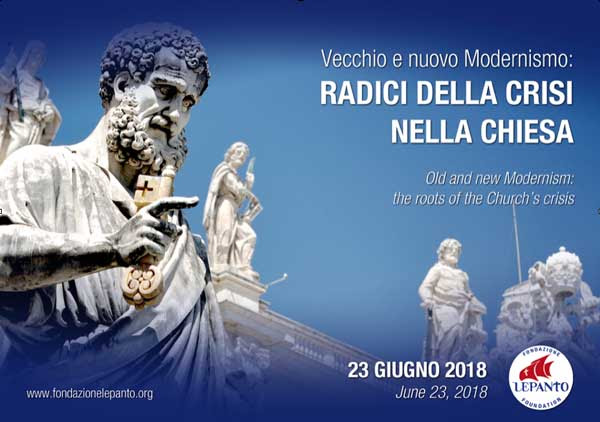
Website: www.fondazionelepanto.org - E-mail: info@fondazionelepanto.org
Corrupt bishops: why it is a problem: Part 1
The shocking news about Cardinal McCarrick prompts me to repost this, from September 2014. The subsequent posts on the series can be seen here and here.
------------------------------
It is hard to think of a precedent in England and Wales for what has happened to Bishop Kieran Conry, though there are plenty from other countries. The downfall of Cardinal O'Brien over the border in Scotland is an obvious one, a closer parallel, however, is afforded by the career of late Bishop of Argyll and the Isles (in north west Scotland), 'Roddy' Wright. I discussed this on this blog because Mgr Basil Loftus had declared that Bishop Wright had merely wanted to get married to the woman he loved. How sweet. Loftus neglected to mention that the wretched Wright had been having affairs with two women, one of them married, simultaneously, and eloped (this was back in 1996) with the one by whom he had not had a child; other affairs had apparently preceded this.
I have no wish to engage in prurient judgmentalism about Bishop Conry, but precisely because this is a new thing for us in England and Wales it is important to consider what we should learn from it.
What Basil Loftus would like us to conclude - and Catherine Pepinster, editor of the Tablet, was quick to make this point on Twitter - is that it is further evidence that mandatory clerical celibacy should be ended. This reaction has become such an ingrained reflex among liberals that they haven't stopped to think about the circumstances of this case. What sort of 'marriage' would have suited Bishop Conry or Bishop Wright? Some sort of free-wheeling polyamorous ménage, one assumes, open to women who are inconveniently married to other men, men who aren't necessarily very happy about sharing the marital bed with their bishop.
No, one must recognise this for what it is. Liberals can talk chirpily about priests merely 'falling in love', and how the problem could be solved by letting them marry, but there is a huge problem here of the priest's spiritual authority, a problem exacerbated when the cleric is a bishop. I've no idea what happened with Bishop Conry, but the stereotyped story, which has happened often enough, is of a woman who comes to a priest with a problem about her marriage, and if the priest is 'down with the kids' and lacks the formality and boundaries vital for the job, they end up in bed together. The priest may be a calculating serial adulterer or he may be naive, but this isn't a normal relationship of equals, or even a 'normal' adulterous affair, because the priest's spiritual authority has the effect of making the women think that, at least in its opening stages, what is happening must be ok, and anyway she is both in awe of him, and aware that he can make things difficult for her if resists. The priest's prestige and authority makes the situation intrinsically problematic, even abusive.
In the recent past, when sanity had not yet departed the education system in despair, it was thought a matter of serious professional misconduct for a teacher or even university tutor to have an affair with a pupil or student, because the teacher's prestige, in the student's eyes, and power over the student, makes the whole thing unfair. This is true to a far greater extent with priests, and even more so with bishops.
Does this mean that it would be hugely problematic simply to end 'clerical celibacy'? Yes it does. How do the Orthodox deal with the problem? They don't: their priests and bishops are not allowed to marry. How can this reality be conveyed through the liberals' thick skulls? Let me say it again: the Orthodox churches do not permit priests and bishops to marry. On the eve of their diaconate seminarians conventionally find a wife, before ordination; if she dies, they may not remarry. Only celibates - generally speaking that means monks - are consecrated bishops. Priests flirting and courting and getting married among the Orthodox? No, no, no.
Please note that when serious people talk about changing the discipline of celibacy in the Latin Church, they are talking about the possibility of adopting the Orthodox approach, and that is what the concessions to convert Anglican clerics amounts to. No serious person imagines that the Church could just allow priests to marry. And married bishops? Forget it. And will priests be allowed to have a series of adulterous affairs one day? Er...
How do the Anglicans manage it? As best they can. One can at least observe that their theology of the ordained ministry does not place create quite such a disproportion of power in the cleric vis-a-vis the object of his, or her, attentions; that courtship and marriage during training or very early in a clerical career is somewhat less problematic, than later; and that clerical courtships have always provided our separated brethren with a rich vein of humour. Who can forget Trollope's superb fictional widow Mrs Bold boxing the ear of the insufferable bishop's chaplain, Mr Slope, in response to his proposal of marriage? The tremulous advances of Dr. Chasuble towards Miss Prism in Oscar Wilde's The Importance of Being Earnest? Or Sydney Smith's observation:
How can a bishop marry? How can he flirt? The most he can say is, 'I will see you in the vestry after service.'
When it comes to priests bound by a vow of celibacy, dealing with (often married) women in a very vulnerable emotional state, seduction, however, is no laughing matter. It is not a peccadillo we should shrug off indulgently. It is a very serious moral evil, with an ever-widening circle of victims. By all means let us pray for Bishop Conry. The revelation of his crimes should make us more vigilant, not less, about the way priests behave.
It is time we put the boot on the other foot. When this kind of thing happens, we must learn to say, not that the rules should be relaxed somehow, but that the touchy-feely, hugging-and-kissing, face-to-face confession, open-necked shirt approach to the priesthood is collapsing under its own contradictions. A more traditional conception of the priesthood is actually the only one which is going to stop behaviour in which women are hurt, children are hurt, husbands are hurt, parishes are hurt, and priests are ultimately destroyed.
 |
| Ordinations in the Traditional rite for the FSSP in Denton, Nabraska, USA |
Support the work of the LMS by becoming an 'Anniversary Supporter'.

